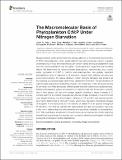| dc.contributor.author | Liefer, Justin D. | |
| dc.contributor.author | Garg, Aneri | |
| dc.contributor.author | Fyfe, Matthew H. | |
| dc.contributor.author | Irwin, Andrew J. | |
| dc.contributor.author | Benner, Ina | |
| dc.contributor.author | Brown, Christopher M. | |
| dc.contributor.author | Follows, Michael J | |
| dc.contributor.author | Omta, Anne Willem | |
| dc.contributor.author | Finkel, Zoe V. | |
| dc.date.accessioned | 2020-01-22T22:07:04Z | |
| dc.date.available | 2020-01-22T22:07:04Z | |
| dc.date.issued | 2019-04 | |
| dc.date.submitted | 2018-10 | |
| dc.identifier.issn | 1664-302X | |
| dc.identifier.uri | https://hdl.handle.net/1721.1/123547 | |
| dc.description.abstract | Biogeochemical cycles in the ocean are strongly affected by the elemental stoichiometry (C:N:P) of phytoplankton, which largely reflects their macromolecular content. A greater understanding of how this macromolecular content varies among phytoplankton taxa and with resource limitation may strengthen physiological and biogeochemical modeling efforts. We determined the macromolecular basis (protein, carbohydrate, lipid, nucleic acids, pigments) of C:N:P in diatoms and prasinophytes, two globally important phytoplankton taxa, in response to N starvation. Despite their differing cell sizes and evolutionary histories, the relative decline in protein during N starvation was similar in all four species studied and largely determined variations in N content. The accumulation of carbohydrate and lipid dominated the increase in C content and C:N in all species during N starvation, but these processes differed greatly between diatoms and prasinophytes. Diatoms displayed far greater accumulation of carbohydrate with N starvation, possibly due to their greater cell size and storage capacity, resulting in larger increases in C content and C:N. In contrast, the prasinophytes had smaller increases in C and C:N that were largely driven by lipid accumulation. Variation in C:P and N:P was species-specific and mainly determined by residual P pools, which likely represent intracellular storage of inorganic P and accounted for the majority of cellular P in all species throughout N starvation. Our findings indicate that carbohydrate and lipid accumulation may play a key role in determining the environmental and taxonomic variability in phytoplankton C:N. This quantitative assessment of macromolecular and elemental content spanning several marine phytoplankton species can be used to develop physiological models for ecological and biogeochemical applications. | en_US |
| dc.description.sponsorship | Gordon and Betty Moore Foundation (Grant GBMF3378) | en_US |
| dc.language.iso | en | |
| dc.publisher | Frontiers Media | en_US |
| dc.relation.isversionof | http://dx.doi.org/10.3389/fmicb.2019.00763 | en_US |
| dc.rights | Creative Commons Attribution 4.0 International license | en_US |
| dc.rights.uri | https://creativecommons.org/licenses/by/4.0/ | en_US |
| dc.source | Frontiers | en_US |
| dc.title | The Macromolecular Basis of Phytoplankton C:N:P Under Nitrogen Starvation | en_US |
| dc.type | Article | en_US |
| dc.identifier.citation | Liefer, Justin D. et al. "The Macromolecular Basis of Phytoplankton C:N:P Under Nitrogen Starvation." Frontiers in Microbiology 10 (April 2019): 763 © 2019 The Author(s) | en_US |
| dc.contributor.department | Massachusetts Institute of Technology. Department of Earth, Atmospheric, and Planetary Sciences | en_US |
| dc.relation.journal | Frontiers in Microbiology | en_US |
| dc.eprint.version | Final published version | en_US |
| dc.type.uri | http://purl.org/eprint/type/JournalArticle | en_US |
| eprint.status | http://purl.org/eprint/status/PeerReviewed | en_US |
| dc.date.updated | 2020-01-22T13:15:54Z | |
| dspace.date.submission | 2020-01-22T13:15:56Z | |
| mit.journal.volume | 10 | en_US |
| mit.license | PUBLISHER_CC | |
| mit.metadata.status | Complete | |
